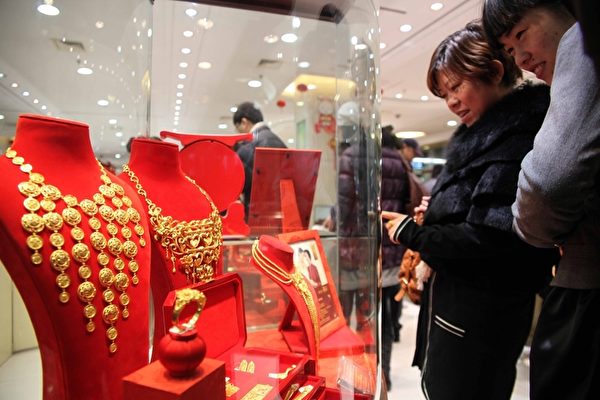On November 23, the news that “carcinogens in cheap jewelry exceed standards by over 9000 times” went viral in mainland China, sparking public concerns about the safety of Chinese gold and silver jewelry. It is worth noting that this exposed issue has long existed, but the oversight by various levels of the Chinese Communist Party has been ineffective.
Reports from mainland Chinese media such as Guangzhou Daily, Qilu Evening News, and Xinjing News on Monday (November 24) revealed shocking findings. Twenty stores, both online and offline, were randomly selected to purchase 21 samples for testing. The results were alarming: among the 21 samples, 17 did not meet the standard coating thickness. For instance, a “silver-plated” bracelet had a silver coating thickness of only 0.24 microns, far below the standard of 2 microns, a difference of over 8 times. Likewise, a “gold-plated” bracelet had a gold coating thickness of only 0.03 microns, significantly lower than the standard of 0.5 microns, a difference of 16 times.
Even more shocking was the discovery of a pair of earrings from a wholesale jewelry market in Guangzhou. Although labeled as “S925 silver,” testing revealed that the primary component was cadmium, a first-class carcinogen, with a content exceeding the standard by over 9000 times.
S925 silver is an internationally recognized purity mark for silver products, indicating a silver content of 92.5%, with the remaining 7.5% consisting of other metals.
Zuo Ying, director of the Quality Inspection Institute’s Lightweight Department at the Shanghai Quality Inspection Institute, stated, “Cadmium is a first-class carcinogen that accumulates in the body and is difficult to metabolize, posing a risk of cancer with prolonged exposure.” The cadmium content in this jewelry was found to be 9.28×10^5 milligrams per kilogram, equivalent to 92.8% cadmium content, significantly exceeding the national mandatory standard of less than or equal to 100 milligrams per kilogram.
In recent days, dermatologists at Beijing University People’s Hospital have seen multiple patients experiencing allergic reactions such as skin redness, swelling, itching, and peeling due to prolonged wearing of alloy jewelry, diagnosed as “jewelry dermatitis.” The occurrence of jewelry dermatitis is closely related to the material of the jewelry, particularly nickel, cadmium, and other heavy metal components, which are often the main culprits for allergies.
Furthermore, in wholesale jewelry markets in cities like Guangzhou, Changsha, and Anhui, bracelets, necklaces, and other jewelry items are priced very low, attracting a large number of consumers. Many jewelry items are sold in bulk, with prices ranging from a few dollars to around two hundred dollars, and some earrings are priced as low as one dollar.
The issue of toxic heavy metals exceeding standards and insufficiency of gold and silver content in jewelry exposed this time is not an isolated case but a long-standing problem due to the failure of supervision by various levels of the Chinese Communist Party.
According to a report by Shangguan News on October 27, the quality inspection center for gold and jewelry in Hangzhou International Jewelry City, Zhejiang Province, found that the nickel release in some “sand gold” jewelry items exceeded the national standard by thousands of times.
As reported by Guangming Daily on August 11, a test conducted by a journalist in Wuhan on 19 pieces of jewelry from a local jewelry store revealed disturbing results: a silver chain with an S925 steel stamp had a silver content of only 13%, and one silver chain was actually made of white copper. Among three purported S925 silver earrings, one was made of iron, one of copper, and only one was silver.
In early August of this year, a well-known assessment blogger, “Lao Ba Pingce,” conducted tests on 8 pairs of earrings marketed as “925 silver” in China. The results revealed that 6 of them were actually copper alloys with severe issues of excess nickel, cadmium, lead, and other heavy metals. Among them, one fake silver piece had a nickel release exceeding the standard by 61 times and a cadmium content exceeding the standard by 1,179 times.
A netizen claiming to have worked in the jewelry industry for over a decade, specializing in silver jewelry for 6 years, revealed characteristics of fake silver jewelry and various “pitfalls” consumers are likely to encounter under the identity of a silver jewelry craftsman named “Yifangpai Yeyougang.”
The article goes on to explain that fake silver jewelry generally falls into two categories: first, those pretending to be silver with materials like white copper, titanium steel, stainless steel plating, or other alloy metals that not only lack silver but often contain heavy metals. The second category includes items that do not meet the national standard silver content but are sold as “pure silver jewelry”.

